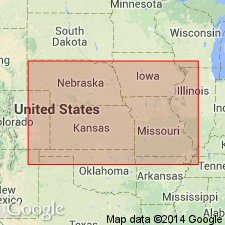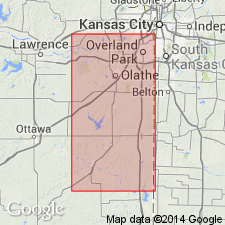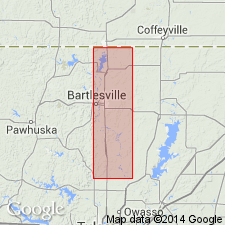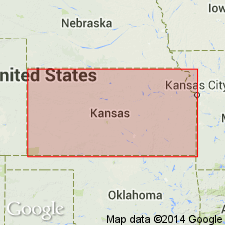
- Usage in publication:
-
- Cottage Grove sandstone
- Modifications:
-
- Overview
- AAPG geologic province:
-
- Cherokee basin
Summary:
Pg. 92, 97. Cottage Grove sandstone in Chanute shale of Kansas City group. In central and southern Kansas the Chanute includes a persistent bed of sandstone (Cottage Grove), and just beneath the sandstone is Thayer coal. These beds persist into northern Oklahoma and are of value in correlation of adjacent limestones. Age is Late Pennsylvanian (Missouri age).
Source: US geologic names lexicon (USGS Bull. 896, p. 529); GNC KS-NE Pennsylvanian Corr. Chart, sheet 2, Oct. 1936.

- Usage in publication:
-
- Cottage Grove sandstone member
- Modifications:
-
- Principal reference
- Dominant lithology:
-
- Sandstone
- AAPG geologic province:
-
- Cherokee basin
Summary:
Pg. 49. Cottage Grove sandstone member of Chanute shale of Kansas City group. For upper sandstone mass of Chanute shale the term Cottage Grove sandstone is here applied, from township in Allen County, Kansas. It overlies Thayer coal. Is generally soft, light-buff, cross-bedded or even-bedded. Thickness 1 to 30 feet. Age is Late Pennsylvanian (Missouri age). [R.C. Moore, 1936, says 50 feet in southern Kansas.]
Source: US geologic names lexicon (USGS Bull. 896, p. 529); GNC KS-NE Pennsylvanian Corr. Chart, sheet 2, Oct. 1936.

- Usage in publication:
-
- Cottage Grove sandstone member
- Modifications:
-
- Overview
- AAPG geologic province:
-
- Cherokee basin
Summary:
Cottage Grove sandstone member of Chanute shale of Kansas City group. Stated that Newell is author of this name. Present in southeastern Kansas. Thickness 50 feet. Age is Late Pennsylvanian (Missourian).
Source: US geologic names lexicon (USGS Bull. 896, p. 529); GNC KS-NE Pennsylvanian Corr. Chart, sheet 2, Oct. 1936.

- Usage in publication:
-
- Cottage Grove sandstone member
- Modifications:
-
- Areal extent
- AAPG geologic province:
-
- Chautauqua platform
Summary:
Pg. 61 (fig. 6), 63-64. Cottage Grove sandstone member of Chanute shale. Described in Washington County, Oklahoma, where it is 6 to 50 feet thick. Occurs above unit referred to as Thayer coal member and below unnamed carbonaceous shale member. Age is Late Pennsylvanian (Missourian).
Source: US geologic names lexicon (USGS Bull. 1200, p. 951).

- Usage in publication:
-
- Cottage Grove sandstone member*
- Modifications:
-
- Overview
- AAPG geologic province:
-
- Cherokee basin
Summary:
Pg. 84. Cottage Grove sandstone member of Chanute shale of Kansas City group. Yellowish-brown or tan thin-bedded to massive sandstone; comprises upper one-third to one-half of Chanute shale in southeastern Kansas; occurs only locally in northeastern Kansas. Thickness featheredge to 60 feet. Age is Late Pennsylvanian (Missourian).
Source: US geologic names lexicon (USGS Bull. 1200, p. 951).
For more information, please contact Nancy Stamm, Geologic Names Committee Secretary.
Asterisk (*) indicates published by U.S. Geological Survey authors.
"No current usage" (†) implies that a name has been abandoned or has fallen into disuse. Former usage and, if known, replacement name given in parentheses ( ).
Slash (/) indicates name conflicts with nomenclatural guidelines (CSN, 1933; ACSN, 1961, 1970; NACSN, 1983, 2005, 2021). May be explained within brackets ([ ]).

